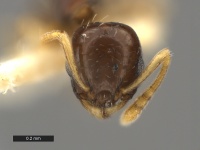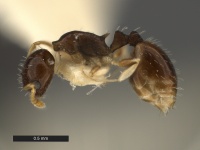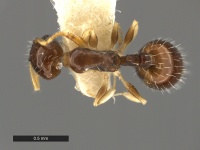Temnothorax tuscaloosae
| Temnothorax tuscaloosae | |
|---|---|

| |
| Scientific classification | |
| Kingdom: | Animalia |
| Phylum: | Arthropoda |
| Class: | Insecta |
| Order: | Hymenoptera |
| Family: | Formicidae |
| Subfamily: | Myrmicinae |
| Tribe: | Crematogastrini |
| Genus: | Temnothorax |
| Species group: | palearctic |
| Species: | T. tuscaloosae |
| Binomial name | |
| Temnothorax tuscaloosae (Wilson, 1951) | |
Workers are small, dark-colored and shiny. When seen in the field they superficially resemble small dark colored Monomorium workers. Colonies are polygynous and have a high proportion of queens to workers.
| At a Glance | • Polygynous |
Identification
Prebus (2017) - A member of the Palearctic clade.
Mackay (2000) - This is a small, dark species with an 11-segmented antenna, Most of the head and mesosoma are smooth and shining, rugae are present on the lower surfaces of the side of the mesosoma, the petiole and postpetiole are finely punctate, the gaster is smooth and glossy. None of the sutures break the dorsum of the mesosoma, the propodeal spines are well developed, long and slender, the petiolar node is low and rounded and the subpeduncular process is poorly developed.
Wilson (1950): Superficially similar to Temnothorax curvispinosus, differing in being dark brown (Temnothorax curvispinosus is light brown), having a nearly smooth dorsal surface of the head (heavily punctate in Temnothorax curvispinosus). The smooth dorsum of the head could result in it being confused with Temnothorax longispinosus. It differs as the propodeal spines are shorter (0.12mm) (0.25mm in Temnothorax longispinosus) and more elevated (angle of about 150° with the dorsal face of the propodeum, whereas the angle in Temnothorax longispinosus is about 180°). Thus it is a distinct species that would be difficult to confuse with any of the others.
Keys including this Species
- Key to Temnothorax longispinosus species group workers
- Key to the New World Temnothorax
- Key to Temnothorax of eastern United States
Distribution
United States: Known from Alabama, Mississippi and North Carolina, U.S.A.
Latitudinal Distribution Pattern
Latitudinal Range: 37.262° to 31.571°.
| North Temperate |
North Subtropical |
Tropical | South Subtropical |
South Temperate |
- Source: AntMaps
Distribution based on Regional Taxon Lists
Nearctic Region: United States (type locality).
Distribution based on AntMaps
Distribution based on AntWeb specimens
Check data from AntWeb
Countries Occupied
| Number of countries occupied by this species based on AntWiki Regional Taxon Lists. In general, fewer countries occupied indicates a narrower range, while more countries indicates a more widespread species. |

|
Estimated Abundance
| Relative abundance based on number of AntMaps records per species (this species within the purple bar). Fewer records (to the left) indicates a less abundant/encountered species while more records (to the right) indicates more abundant/encountered species. |

|
Habitat
Forest
Abundance
This species is known to be abundant in some areas of North Carolina. In Alabama and Mississippi its has not been frequently collected.
Biology
Temnothorax tuscaloosae is unusual in having a high number of queens per colony, with most having functional ovaries. Both the number of queens present within a nests and the fact that such a large number of queens within a nest would be actively producing eggs is rarely observed.
Nesting Habits
| Temnothorax sp. | Acorns / hickory nuts | Sticks / dead roots in leaf litter | Rotten logs / dead standing trees | Hollow plant stems | Rock crevices | Formica nests | Nests of other Temnothorax spp. | Under rock / directly in soil | Galls | Under bark on live trees | Hollow twigs on live trees | Branches on live trees |
|---|---|---|---|---|---|---|---|---|---|---|---|---|
| Temnothorax allardycei | – | x | – | x | – | – | – | – | – | – | x | – |
| Temnothorax ambiguus | x | x | – | x | – | x | – | x | – | – | – | – |
| Temnothorax americanus | x | x | – | – | – | – | x | – | – | – | – | – |
| Temnothorax bradleyi | – | – | – | – | – | – | – | – | – | x | – | – |
| Temnothorax caryaluteus | – | – | – | – | – | – | – | – | – | x | x | x |
| Temnothorax curvispinosus | x | x | x | x | – | – | – | x | x | x | – | – |
| Temnothorax duloticus | x | x | – | – | – | – | x | – | – | – | – | – |
| Temnothorax longispinosus | x | x | x | – | x | – | – | x | – | – | – | – |
| Temnothorax minutissimus | x | – | – | – | – | – | x | – | – | – | – | – |
| Temnothorax palustris | – | – | – | – | – | – | – | x | – | – | – | – |
| Temnothorax pergandei | x | x | x | x | x | – | – | x | – | – | – | – |
| Temnothorax pilagens | x | x | – | – | – | – | x | – | – | – | – | – |
| Temnothorax schaumii | – | – | x | – | – | – | – | – | x | x | x | x |
| Temnothorax smithi | – | – | x | – | – | – | – | – | – | x | – | – |
| Temnothorax texanus | – | – | – | – | – | – | – | x | – | – | – | – |
| Temnothorax torrei | – | x | – | – | – | – | – | – | – | – | – | – |
| Temnothorax tuscaloosae | x | x | – | – | – | – | – | x | – | – | – | – |
Regional Notes
Alabama
The Tuscaloosa type colony was found in a small cavity in a bank of earth under a bed of moss. It was at the base of a large oak in an open area fringing a bay-gum swamp. The Elrod colony was found in a small cavity in the earth covered partly by an overhanging root and party by thin leaf litter. It was in a densely shaded area also on the fringes of a bay-gum swamp. Stray workers were taken during the day on low bushes near both nests. (Wilson 1951)
North Carolina
This ant is common in Eastern North Carolina.
This species is often found nesting in hickory nuts and acorns. Nests can have more than 50 individuals. Colonies are polygynous, often with a high ratio of queens per worker. Workers forage on the ground and these individuals are captured in pitfall traps and litter sampling.
Carter (1962): "All records for this ant were obtained by Berlese funnel from leaf mold and litter. Piedmont collections were taken on May and July 24, 1958, in an oak-hickory-beach forest located west of Durham on N. C. State Highway 98. This mesic stand occupied a moderate slope facing a densely shaded mixed hardwood bottomland forest. Coastal area collections were obtained from oak-hardwood and oak-beech forests. Individuals were especially common in litter sample from the oak-beech forests of Flanner's Beach near the Neuse River. Almost all collections were taken from litter gathered at the base or in the vicinity of beech trees. The Haveloek record was obtained from litter accumulated around the base of a single large beech within an oak-loblolly pine forest. The Kinsont collection, however, was obtained from an oak-hardwood forest. Coastal plain collections were made in June, July, and August."
Castes
Nomenclature
The following information is derived from Barry Bolton's Online Catalogue of the Ants of the World.
- tuscaloosae. Leptothorax tuscaloosae Wilson, 1951: 128 (w.q.) U.S.A. Combination in Temnothorax: Bolton, 2003: 272. See also: Mackay, 2000: 419.
Unless otherwise noted the text for the remainder of this section is reported from the publication that includes the original description.
Description
Worker
Holotype - Total length approximately 1.9 mm.; length of alitrunk, measured from the dorsal base of the pronotal collar to the tip of the posterior propodeal flange, 0.554 mm.; length of head, measured in profile from the anterior margin of the clypeus to the extreme occipital border, 0.512mm.; cephalic index 93.5. (All measurements except total length given in this description with a maximum error of +0.016 mm.)
Eye oval, moderately prominent, with nine ocelli across its greatest length, located nearer the anterior than the posterior border of the head. Head subrectangular, with weakly convex posterior border, rounded posterior angles, and weakly convex, subparallel sides. Clypeus depressed, 1.2 times longer than broad, its anterior border rounded and entire. Antenna eleven-segmented; scape failing by approximately its greatest width to meet the occipital angle; funicular club three-jointed, as long as the remainder of the funiculus, the apical segment longer than the preceding two combined. Mandible with five teeth, the apical tooth the largest. Alitrunk slender, seen from above 0.272 mm. across its greatest width at the pronotum, evenly arcuate in profile, sloping to the base of the propodeal spines; humeri well rounded; pro-mesonotal and mesoepinotal sutures absent; other thoracic sutures weak or absent. Propodeal spines slender and acute, slightly and gradually curved inward and downward, approximately as long as the declivious face of the propodeum, the basal portions in profile forming an angle of approximately 1200 with the basal face of the propodeum, their bases 0.096 mm. apart. Femora and tibiae noticeably incrassated. Petiolar node in profile with anterior face concave, and meeting the dorsal face in a bluntly rounded angle. Dorsum of postpetiole 1.5 times broader than long, not constricted in posterior half, with subparallel sides.
Mandibles covered dorsally by close-set, longitiudinal striae. Clypeus with a dark median carina running from anterior to posterior border; the remainder of the clypeus more or less longitudinally rugulose. Frontal area, frontal lobes, and cheeks rugulose. Remainder of head, most of the thorax, and the gaster moderately shining, with extremely fine punctures. Propodeum and meso- and metasternal regions of thorax rugulose, the rugulae of the declivious face of the propodeum transverse. Petiole and postpetiole densely and coarsely granulose.
Body covered by moderately abundant, long, coarse, grayish, erect hairs. Antennae with moderately abundant, short, very fine hairs over entire surface; many of these hairs on funiculus and a small number on scape sub erect to erect but the maj ority appressed. Legs with a sparse growth of hairs similar to those on antennae; most of these appressed by a scattered few suberect to erect.
Body dark brown; mandibles, antennae, and legs pale yellow; femora infuscated over entire surface except for ends.
Queen
Gynetype. - Differing from the worker in the usual characters separating these two phases. Total length approximately 2.7 mm., length of alitrunk 0.912 mm., greatest width of alitrunk 0.576 mm., length of head 0.568 mm., cephalic index 100. Propodeal spines short and robust, their length less than the distance between their bases and approximately half the length of the declivious face of the propodeum. Sculpturing, pilosity, and color essentially the same as in the worker.
Male
No Males known for this species.
Type Material
The holotype worker, the gynetype, and forty-two paratypes consisting of seven dealate queens and thirty-five workers were collected by the author (Wilson) August 20, 1947, in a small patch of woods directly north of Guthrie's Nursery, which is at the Tuscaloosa Memorial Cemetery near the outskirts of the city.
Thirteen paratypes consisting of two dealate queens and eleven workers were collected by Barry D. Valentine and the author (Wilson) May 10, 1949, in the Sipsey River swamp several miles east of the town. Elrod, Tuscaloosa Co., Ala.
As reported in Mackay (2000) types were seen from the "USNM, MCZC and the University of Alabama" collections.
Type Locality Information
Tuscaloosa, Alabama. in a small patch of woods directly north of Guthrie's Nursery, which is at the Tuscaloosa Memorial Cemetery near the outskirts of the city.
Elrod, Tuscaloosa Co., Ala. Paratypes from east of Elrod, Alabama near the Sipsy River Swamp.
Mackay (2000) reports: "My family and I visited both type localities on 8-vi-1998, and discussed the situation with Mrs. Nevada B. Hubbard, who has been secretary at the Memorial Park Cemetery since the 1940's. The site of Guthrie's Nursery is now part of the Tuscaloosa Memorial Park Cemetery. The type locality is now north of the cemetery shop, situated in Lots 7 and 8 of the cemetery, which is now in use. We were unable to locate this species inside the cemetery. Mrs. Hubbard graciously allowed us to collect in an undeveloped area of the Cemetery, covered with trees and dense foliage. Unfortunately this area is heavily infested with Solenopsis invicta (even the dense forest) and few ant genera were found in the area." and "We also visited the second type locality on the same day, which is located at the Sipsey River Swamp, 2 k E Elrod. This area is heavily disturbed, but is still a swamp with dense vegetation. We thoroughly searched the area, including vegetation, but did not find this species. Solenopsis invicta also occurs in the area, but is not the dominant ant."
These locations are ~ here 33°12′00.1″N 87°27′44.11″W / 33.200028°N 87.4622528°W (Guthries/Memorial Park Cemetery) and here 33°15′25.56″N 87°45′54″W / 33.2571°N 87.765°W (E. of Elrod).
Etymology
Toponym.
References
- Guenard, B., Shik, J.Z., Booher, D., Lubertazzi D., Alpert G. (2016) Extreme polygyny in the previously unstudied subtropical ant Temnothorax tuscaloosae (Hymenoptera: Formicidae), with implications for the biogeographic study of the evoluiton of polygyny. Insectes Sociaux.
- Bolton, B. 2003. Synopsis and Classification of Formicidae. Mem. Am. Entomol. Inst. 71: 370pp (page 272, Combination in Temnothorax)
- Carter, W. G. 1962. Ant distribution in North Carolina. Journal of the Elisha Mitchell Scientific Society. 78:150-204.
- MacKay, W. P. 2000. A review of the New World ants of the subgenus Myrafant, (genus Leptothorax) (Hymenoptera: Formicidae). Sociobiology 36: 265-444 (page 419, see also)
- Prebus, M. 2017. Insights into the evolution, biogeography and natural history of the acorn ants, genus Temnothorax Mayr (hymenoptera: Formicidae). Bmc Evolutionary Biology. 17:250. doi:10.1186/s12862-017-1095-8 (The doi link to the publication's journal webpage provides access to the 24 files that accompany this article).
- Prebus, M.M., Nguyen, N., Doering, G.N., Booher, D.B. 2024. Temnothorax caryaluteus sp. nov. (Hymenoptera: Formicidae): a new ant species from the eastern United States. European Journal of Taxonomy 970, 175–202 (doi:10.5852/ejt.2024.970.2757).
- Wilson, E. O. 1951. A new Leptothorax from Alabama (Hymenoptera: Formicidae). Psyche. 57:128-130. (page 128, worker, queen described)
References based on Global Ant Biodiversity Informatics
- Booher Doug. Personal communication, September 2014.
- Forster J.A. 2005. The Ants (hymenoptera: Formicidae) of Alabama. Master of Science, Auburn University. 242 pages.
- Ivanov K., L. Hightower, S. T. Dash, and J. B. Keiper. 2019. 150 years in the making: first comprehensive list of the ants (Hymenoptera: Formicidae) of Virginia, USA. Zootaxa 4554 (2): 532–560.
- MacGown J. A., J. G. Hill, and R. L. Brown. 2010. Native and exotic ant in Mississippi state parks. Proceedings: Imported Fire Ant Conference, Charleston, South Carolina, March 24-26, 2008: 74-80.
- MacGown J. A., and R. L. Brown. 2006. Survey of the ants (Hymenoptera: Formicidae) of the Tombigbee National Forest in Mississippi. Journal of the Kansas Entomological Society 79(4):325-340.
- MacGown, J.A and J.A. Forster. 2005. A preliminary list of the ants (Hymenoptera: Formicidae) of Alabama, U.S.A. Entomological News 116(2):61-74
- Menzel T. O., and T. E. Nebeker. 2008. Distribution of Hybrid Imported Fire Ants (Hymenoptera: Formicidae) and Some Native Ant Species in Relation to Local Environmental Conditions and Interspecific Competition in Mississippi Forests. Ann. Entomol. Soc. Am. 101(1): 119-127.
- Wilson E. O. 1951. A new Leptothorax from Alabama (Hymenoptera: Formicidae). Psyche (Cambridge) 57: 128-130.




